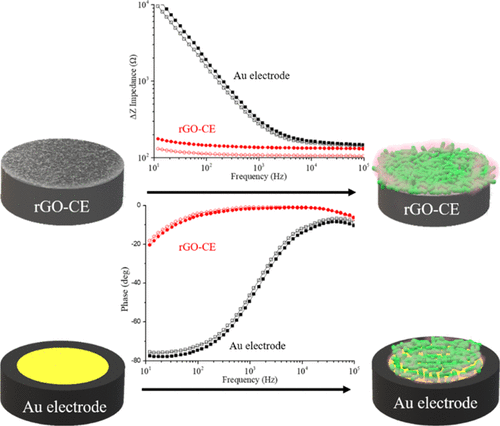Our official English website, www.x-mol.net, welcomes your
feedback! (Note: you will need to create a separate account there.)
Enhanced Electrochemical Impedance Spectroscopy Analysis of Microbial Biofilms on an Electrochemically In Situ Generated Graphene Interface.
ACS Sensors ( IF 8.2 ) Pub Date : 2020-05-13 , DOI: 10.1021/acssensors.0c00570 Jin Song 1, 2 , Yiwei Li 3 , Fang Yin 2 , Zhitao Zhang 2 , Dingkun Ke 2 , Dianbing Wang 2 , Qipeng Yuan 1 , Xian-En Zhang 2, 4
ACS Sensors ( IF 8.2 ) Pub Date : 2020-05-13 , DOI: 10.1021/acssensors.0c00570 Jin Song 1, 2 , Yiwei Li 3 , Fang Yin 2 , Zhitao Zhang 2 , Dingkun Ke 2 , Dianbing Wang 2 , Qipeng Yuan 1 , Xian-En Zhang 2, 4
Affiliation

|
Biofilms can cause many bacterial diseases, such as dental disease. An in vitro detection of biofilms may help to screen antibiofilm drugs. An impedance measurement based on an Au electrode has been successfully used for in vitro real-time monitoring of animal and human cell growth. However, microbial growth on the Au electrode produced a poor signal because of the small size of microbial cells. We have recently demonstrated that graphene derivatives can be produced on a carbon electrode through facile electrochemical activation, thus forming a reduced graphene oxide-carbon electrode (rGO-CE). Based on this fact, we hypothesized that an in vitro formed rugose graphene layer of rGO-CE may provide a large surface area for the growth of microbial biofilms and can therefore produce a strong impedance signal in response to a change in the biomass. In this study, three oral bacteria, Streptococcus mutans (S. mutans), Actinomyces viscosus (A. viscosus), and Lactobacillus fermentum (L. fermentum), were cultured on the surfaces of rGO-CE. As a result, the impedance response signal of the rGO-CE for the growth of S. mutans and A. viscosus was found to be 3.3 times and 6.0 times stronger than that of the Au electrode at 1.17 and 54.7 kHz, respectively. In particular, the poorly adhering strain of L. fermentum also produced a detectable signal on the graphene electrode but not on the Au electrode at 1.17 kHz. Furthermore, destructions of the biofilms grown on the rGO-CE by cetylpyridinium chloride were successfully monitored by impedance changes. Overall, it is promising to develop a graphene-based impedance biosensor platform for biofilm study and antibiofilm drug screening.
中文翻译:

电化学生成的石墨烯界面上微生物生物膜的增强电化学阻抗谱分析。
生物膜可以引起许多细菌性疾病,例如牙齿疾病。在体外生物膜的检测可以帮助屏幕抗生物膜的药物。基于金电极的阻抗测量已成功用于动物和人类细胞生长的体外实时监测。但是,由于微生物细胞的尺寸小,金电极上的微生物生长会产生不良信号。最近我们已经证明,可以通过容易的电化学活化在碳电极上生成石墨烯衍生物,从而形成还原的氧化石墨烯-碳电极(rGO-CE)。基于这一事实,我们假设在体外rGO-CE形成的皱纹石墨烯层可以为微生物生物膜的生长提供较大的表面积,因此可以响应于生物质的变化而产生强阻抗信号。在这项研究中,三个口腔细菌,变形链球菌(变形链球菌),粘性放线菌(A.粘性),和发酵乳杆菌(发酵乳杆菌),进行RGO-CE的表面上培养。结果,rGO -CE的阻抗响应信号对变形链球菌和黏稠曲霉的生长据发现,在1.17和54.7 kHz频率下,金电极的强度分别比金电极强3.3倍和6.0倍。特别地,发酵乳杆菌的不良粘附应变还在1.17kHz下在石墨烯电极上而非在Au电极上产生可检测的信号。此外,通过阻抗变化成功监测了氯化十六烷基吡啶对rGO-CE上生长的生物膜的破坏。总体而言,有望为生物膜研究和抗生物膜药物筛选开发基于石墨烯的阻抗生物传感器平台。
更新日期:2020-06-26
中文翻译:

电化学生成的石墨烯界面上微生物生物膜的增强电化学阻抗谱分析。
生物膜可以引起许多细菌性疾病,例如牙齿疾病。在体外生物膜的检测可以帮助屏幕抗生物膜的药物。基于金电极的阻抗测量已成功用于动物和人类细胞生长的体外实时监测。但是,由于微生物细胞的尺寸小,金电极上的微生物生长会产生不良信号。最近我们已经证明,可以通过容易的电化学活化在碳电极上生成石墨烯衍生物,从而形成还原的氧化石墨烯-碳电极(rGO-CE)。基于这一事实,我们假设在体外rGO-CE形成的皱纹石墨烯层可以为微生物生物膜的生长提供较大的表面积,因此可以响应于生物质的变化而产生强阻抗信号。在这项研究中,三个口腔细菌,变形链球菌(变形链球菌),粘性放线菌(A.粘性),和发酵乳杆菌(发酵乳杆菌),进行RGO-CE的表面上培养。结果,rGO -CE的阻抗响应信号对变形链球菌和黏稠曲霉的生长据发现,在1.17和54.7 kHz频率下,金电极的强度分别比金电极强3.3倍和6.0倍。特别地,发酵乳杆菌的不良粘附应变还在1.17kHz下在石墨烯电极上而非在Au电极上产生可检测的信号。此外,通过阻抗变化成功监测了氯化十六烷基吡啶对rGO-CE上生长的生物膜的破坏。总体而言,有望为生物膜研究和抗生物膜药物筛选开发基于石墨烯的阻抗生物传感器平台。











































 京公网安备 11010802027423号
京公网安备 11010802027423号